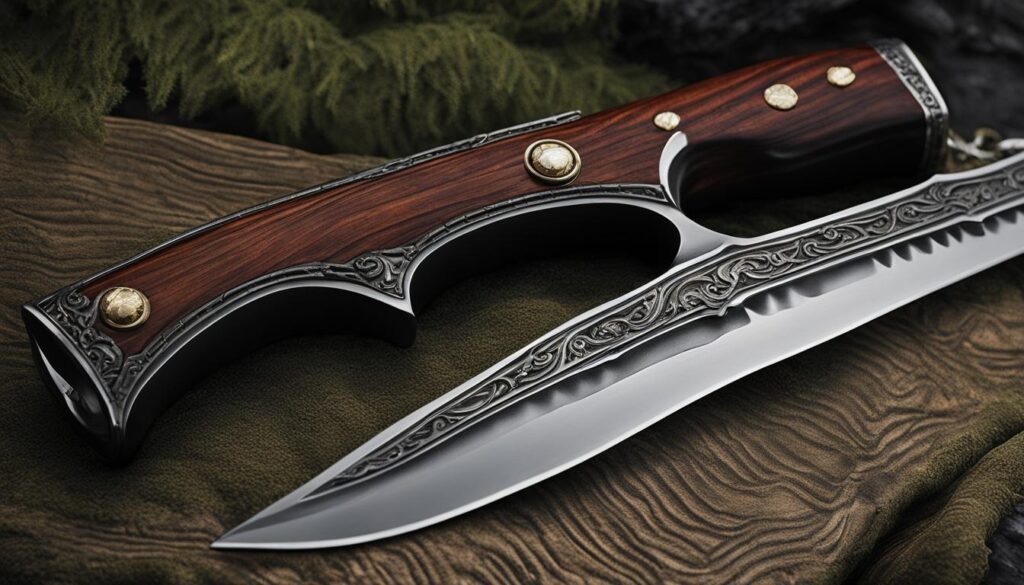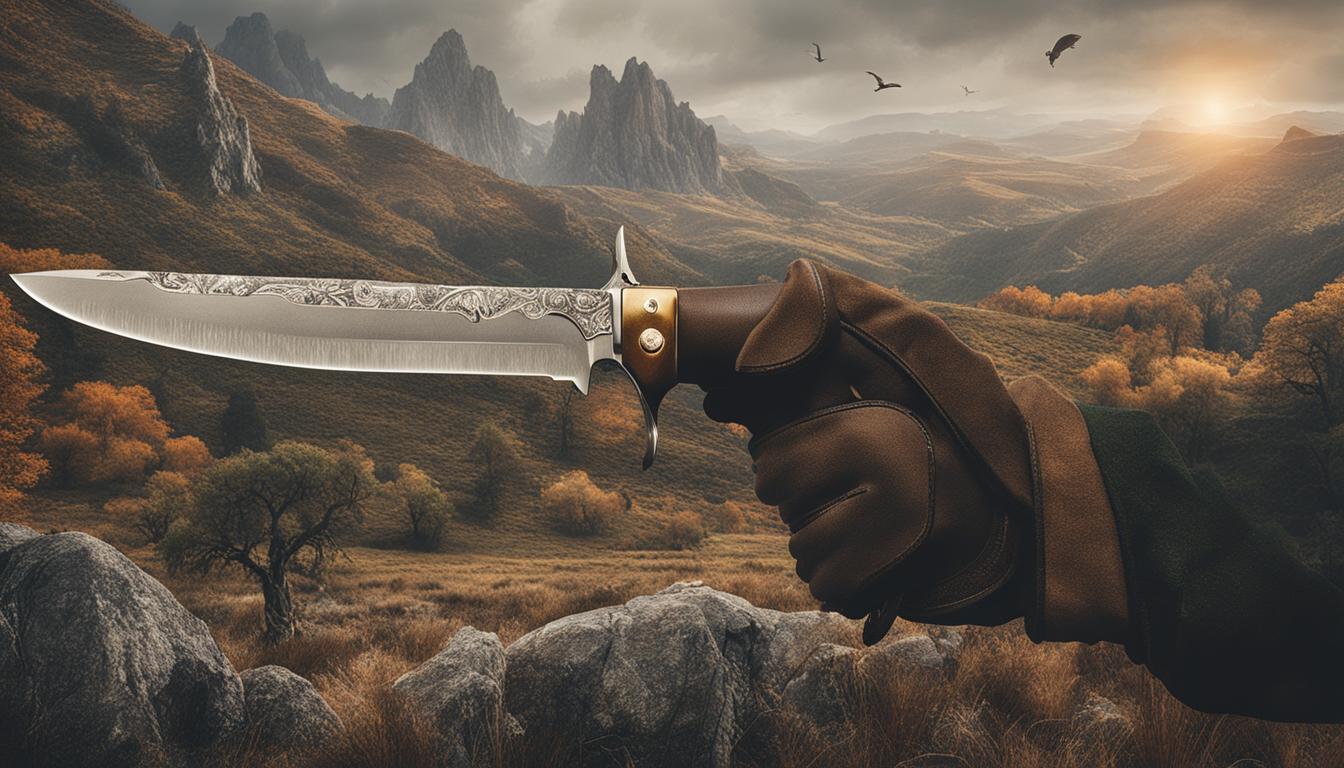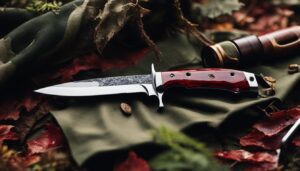Hunting knives are indispensable tools for hunters, serving a variety of purposes such as skinning, meat cutting, and boning. However, it is essential for hunters to familiarize themselves with hunting knife regulations and legalities to ensure their safety and compliance with the law.
When it comes to handling knives, hunters must exercise caution and adhere to proper safety guidelines. This includes using a sharp knife, choosing the right knife for the task at hand, cutting away from the body, and securely storing the knife in a sheath when not in use.
Understanding hunting knife regulations is crucial for hunters to ensure their safety and compliance with the law. It enables them to make informed choices when it comes to selecting the right tools for their outdoor pursuits. Let’s delve deeper into the different types of hunting knives, choosing the right knife, key features to consider, blade materials, and the importance of knife handles.
Key Takeaways:
- Hunting knife regulations and legalities are important for hunters to understand and comply with.
- Proper knife handling techniques and safety guidelines should be followed to prevent accidents.
- There are various types of hunting knives, each serving specific purposes in the field.
- Choosing the right hunting knife involves considering factors such as intended use, size, and blade design.
- Blade materials and handle materials have different properties that affect performance and durability.
The Different Types of Hunting Knives and Their Uses
When it comes to hunting, having the right tools is essential. And one of the most important tools for any hunter is a hunting knife. However, not all hunting knives are created equal, and different types serve specific purposes. In this section, we will explore the various types of hunting knives and their uses.
1. Camp Knife:
A camp knife is a versatile tool that can handle a wide range of tasks around the campsite. It typically has a medium-sized blade and a durable handle, making it suitable for tasks such as chopping firewood, preparing meals, and general bushcraft.
2. Skinning Knife:
A skinning knife is designed specifically for the skinning process. It features a short, thin blade that allows for precise cuts and minimizes the risk of puncturing the hide. The blade is typically curved, making it easier to separate the skin from the meat.
3. Gutting Knife:
A gutting knife is used for field dressing game. It has a uniquely shaped blade that is optimized for opening the animal’s body cavity and removing the internal organs. The blade is often curved and features a gut hook, which aids in making a clean cut without damaging the intestines.
4. Deboning Knife:
A deboning knife is used to remove meat from bones. It has a thin, flexible blade that allows for precise cuts and maneuverability around joints. This type of knife is particularly useful for butchering game animals and preparing cuts of meat.
5. Hunting Dagger:
A hunting dagger is a long, sturdy fixed blade knife that is primarily used for hunting boars. It has a thick blade and a sharp, pointed tip, making it capable of penetrating tough hides and delivering lethal blows. The design of a hunting dagger emphasizes durability and strength.
Each type of hunting knife has its own unique characteristics and uses. It’s important for hunters to understand these differences and choose the right knife for the specific tasks they will be performing in the field. By doing so, hunters can ensure that they have a tool that is both efficient and safe to use.
Choosing the Right Hunting Knife
When it comes to selecting a hunting knife, there are several factors to consider in order to make the right choice. The intended use of the knife should be at the forefront of your decision-making process. Are you looking for a knife specifically for skinning or field dressing, or do you require a versatile option that can handle a variety of tasks? Having a clear understanding of your needs will help guide your selection.
Size also plays a crucial role in choosing the right hunting knife. Consider the type of game you will be hunting and the tasks you need to perform. For larger animals, a longer, more substantial blade may be necessary, while smaller game may only require a compact knife. It’s important to find a balance between functionality and portability.
Blade design is another important consideration. Different blade designs, such as drop point, clip point, and skinning blades, offer unique advantages and are suited for specific tasks. For example, a drop point blade is versatile and offers good control, making it ideal for general-purpose use. On the other hand, a skinning blade has a curved design that excels at efficiently removing animal hides.
| Factors to Consider | Details |
|---|---|
| Intended Use | Specialized tasks or versatility |
| Size | Consider the type of game and tasks |
| Blade Design | Drop point, clip point, skinning blades |
Additionally, the type of blade material and handle material should not be overlooked. Blade materials such as stainless steel, carbon steel, or high-quality alloys can impact sharpness, durability, and corrosion resistance. Similarly, the handle material should provide a secure grip even in wet conditions. Synthetic handle materials like Zytel, Kraton, and ABS are known for their durability and grip, while natural materials like wood and bone may offer aesthetic appeal but may not be as practical.
Ultimately, choosing the right hunting knife involves a careful balance of functionality, durability, and personal preference. By considering factors such as intended use, size, blade design, blade material, and handle material, you can ensure that your hunting knife meets your specific needs and performs reliably in the field.
Key Features to Consider in a Hunting Knife
When choosing a hunting knife, there are several key features that you should consider to ensure you select the right tool for your needs. These features can impact the knife’s functionality, safety, and legality. Here are some important factors to keep in mind:
Type of Blade: Fixed or Folding
The first decision you need to make is whether you want a fixed-blade or folding knife. Fixed-blade knives are generally more durable and stronger, making them ideal for heavy-duty tasks such as field dressing and chopping. Folding knives, on the other hand, offer convenience and portability as they can be easily folded and stored in your pocket. It’s crucial to note that the legality of carrying a folding knife may vary depending on local hunting knife regulations.
Gut Hook
A gut hook is a specialized feature found on some hunting knives. This small, curved blade on the back of the main blade is designed to make it easier to field dress game by opening the abdominal cavity without puncturing the internal organs. If you frequently engage in this task, a hunting knife with a gut hook can be a valuable addition to your toolkit.
Handle Material and Grip
The handle material plays a significant role in providing a secure grip and comfortable handling. Synthetic handle materials such as G10, rubber, or textured composite materials offer excellent grip even in wet conditions. Wood, bone, and other natural materials may be aesthetically pleasing but may not provide the same level of grip, especially when wet. Choose a handle material that suits your personal preferences and ensures a secure grip for safe and efficient knife use.
Blade Type
The type of blade design determines the knife’s functionality and intended use. Different blade types, such as clip point, drop point, and tanto, have unique characteristics and advantages. Clip point blades are versatile and suitable for various tasks, while drop point blades are excellent for skinning and dressing game. Tanto blades are known for their strength and piercing capabilities. Consider your specific needs and the tasks you’ll be performing to choose the most appropriate blade type for your hunting knife.
By considering these key features in a hunting knife, you can make an informed decision and choose a knife that meets your requirements, complies with hunting knife legalities, and enhances your hunting experience.
Understanding Knife Blade Materials
When it comes to hunting knives, the type of steel used in the blade plays a crucial role in determining its overall performance and durability. Different blade materials offer varying levels of sharpness, edge retention, corrosion resistance, and wear resistance. Understanding the characteristics and advantages of different blade materials can help hunters make informed decisions when choosing their knives.
Popular Blade Materials
There are several popular blade materials used in hunting knives, each with its own unique properties. Let’s take a look at some of them:
- S30V: Known for its excellent edge retention and corrosion resistance, S30V is a premium stainless steel often used in high-quality hunting knives.
- 154CM: This stainless steel is prized for its superior toughness and corrosion resistance, making it a popular choice among hunters.
- VG-10: VG-10 is a high-performance stainless steel known for its impressive sharpness and ability to maintain an edge.
- 420HC: 420HC is a budget-friendly stainless steel that offers good corrosion resistance and ease of sharpening.
Choosing the Right Blade Material
When selecting a hunting knife, consider the specific requirements of your hunting activities. If you need a blade that stays sharp for extended periods without frequent sharpening, materials like S30V or VG-10 are excellent choices. On the other hand, if you prioritize ease of sharpening and affordability, 420HC can be a suitable option. Keep in mind that different blade materials may require varying degrees of maintenance to prevent rust or other forms of corrosion.
| Blade Material | Edge Retention | Corrosion Resistance | Sharpening Difficulty |
|---|---|---|---|
| S30V | Excellent | Excellent | Moderate |
| 154CM | Good | Excellent | Moderate |
| VG-10 | Excellent | Good | Moderate |
| 420HC | Good | Good | Easy |
No single blade material is perfect for all hunting situations. It’s essential to consider your specific needs, preferences, and budget when choosing the right blade material for your hunting knife. By understanding the strengths and weaknesses of different materials, you can select a blade that will serve you well in the field.

Importance of Knife Handles
When it comes to hunting knives, the importance of the handle cannot be overlooked. A good handle provides a secure and comfortable grip, especially in wet or slippery conditions. It ensures that you have full control over the knife, reducing the risk of accidents and improving your overall hunting experience.
There are different materials used for knife handles, each offering its own set of advantages and considerations. Synthetic handle materials like Zytel, Kraton, and ABS are popular choices due to their durability, excellent grip, and resistance to moisture and chemicals. These materials provide a reliable and comfortable grip, giving you confidence in your knife’s performance.
On the other hand, natural handle materials like wood and bone are aesthetically pleasing and can give your knife a classic and timeless look. However, they may not offer the same level of durability and grip as synthetic materials. It’s important to weigh the pros and cons and choose a handle material that meets your specific needs and preferences.
In addition to the material, the handle design is also crucial. A good hunting knife handle should have a finger stop or guard to prevent your hand from sliding forward onto the blade. This feature adds an extra layer of safety and helps you maintain a firm grip on the knife.
Table: Comparison of Hunting Knife Handle Materials
| Handle Material | Pros | Cons |
|---|---|---|
| Synthetic (Zytel, Kraton, ABS) | Durable, excellent grip, moisture and chemical resistant | May lack the aesthetic appeal of natural materials |
| Wood | Aesthetically pleasing, classic look | Less durable, may require maintenance |
| Bone | Aesthetically pleasing, unique patterns | Less durable, may be slippery when wet |
Choosing the right handle material and design is essential for a hunting knife that feels comfortable in your hand and performs well in the field. Consider your specific hunting environment, personal preferences, and intended use when making your decision.


Conclusion
Understanding hunting knife regulations is crucial for hunters to ensure their safety and compliance with the law. Different types of hunting knives serve specific purposes, and choosing the right knife involves considering factors such as intended use, size, blade design, blade material, and handle material. By having knowledge of hunting knife regulations and making informed choices, hunters can equip themselves with the right tools for their outdoor pursuits.
Hunting knife regulations help to promote safe and responsible hunting practices. It is important for hunters to know the laws regarding the carrying and use of knives in their specific hunting areas. Being aware of any blade length restrictions, knife carry laws, and prohibited knife features can prevent potential legal issues and ensure a trouble-free hunting experience.
In addition to legal considerations, understanding hunting knife regulations can also enhance hunter safety. Choosing the appropriate knife for the task at hand minimizes the risk of accidents and injuries. A well-maintained and properly used hunting knife can make field dressing, skinning, and other hunting activities more efficient and effective.
Ultimately, hunters should prioritize their safety and the well-being of the animals they hunt. By adhering to hunting knife regulations, they not only comply with the law but also demonstrate their commitment to responsible hunting practices. So, before heading out on your next hunting adventure, take the time to familiarize yourself with the hunting knife regulations in your area and choose your knife wisely.
FAQ
What are some key knife handling safety tips for hunters?
Some key knife handling safety tips include using a sharp knife, using the right knife for the job, cutting away from the body, and securing the knife in a sheath when not in use.
What are the different types of hunting knives and their uses?
The different types of hunting knives include camp knives, skinning knives, gutting knives, deboning knives, and hunting daggers, each serving specific purposes such as cutting meat, boning, and skinning.
How do I choose the right hunting knife?
When choosing a hunting knife, consider factors such as intended use, size, blade design, blade material, and handle material. It is also important to choose a specialized knife if you have specific tasks in mind.
What are some key features to consider in a hunting knife?
Some key features to consider in a hunting knife include the presence of a gut hook, whether the blade is fixed or folding, the handle material, and the type of blade.
What are some popular blade materials for hunting knives?
Some popular blade materials for hunting knives include S30V, 154CM, VG-10, and 420HC, each offering different advantages in terms of sharpness, edge retention, and resistance to corrosion and wear.
Why is the handle of a hunting knife important?
The handle of a hunting knife is important for providing a proper grip, especially in wet conditions. Synthetic handle materials such as Zytel, Kraton, and ABS offer a sure grip and durability, while natural materials like wood and bone may not offer the same level of grip and durability.





